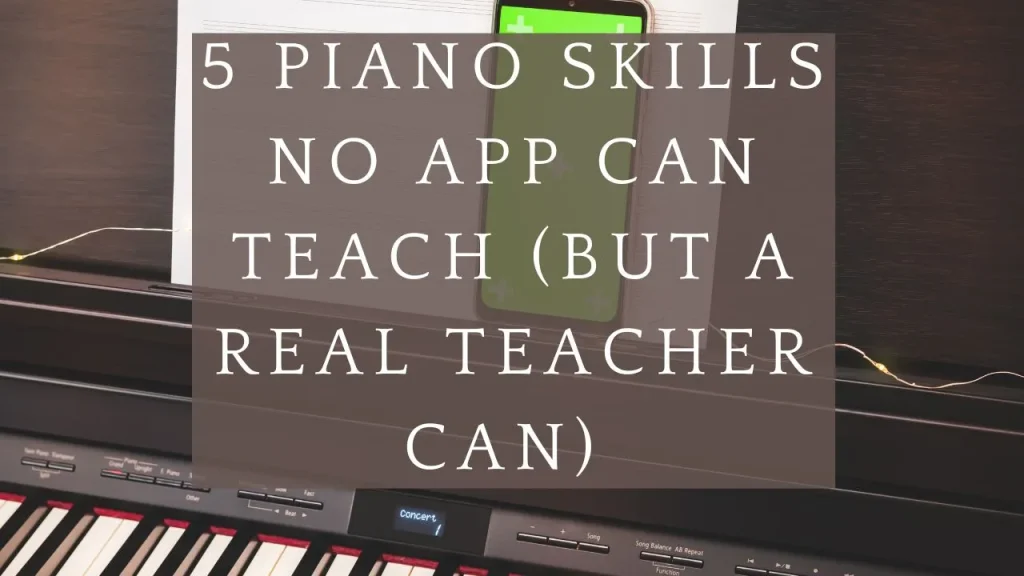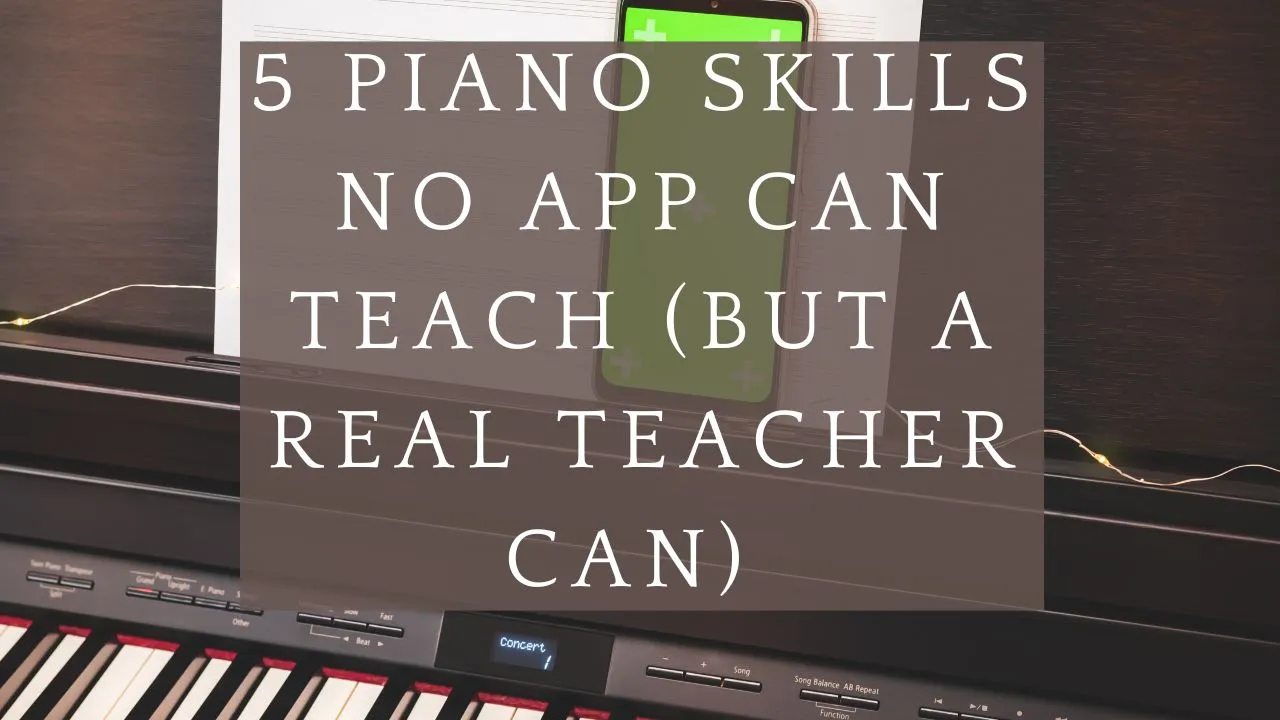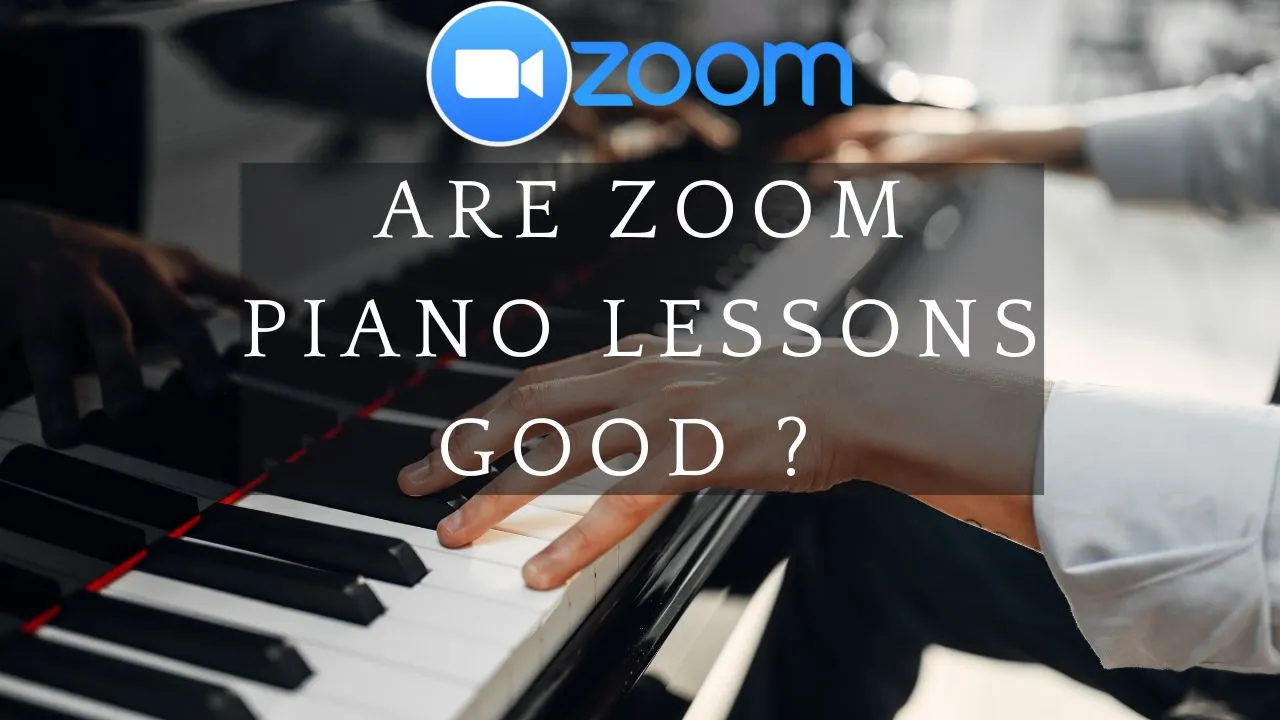As a piano teacher, I’m always interested in a student’s background and their reasons for wanting to learn the piano. These days, it’s all too common for my adult students to say that they started learning on a piano app but quickly realised it is no substitute for a real piano teacher.
Many elements—such as technique, tone quality, balance, and stylistic considerations—simply cannot be conveyed through an app. Furthermore, the human side of learning piano, including the social aspect, cannot be replicated by technology.
Piano learning apps have become incredibly popular, promising convenient and affordable music education at your fingertips. Whilst these digital tools can certainly help with note recognition and basic repertoire, they fall short in teaching the nuanced skills that distinguish a well-rounded pianist from someone who merely presses the right keys at the right time.
Research from Beijing’s Central University of Finance and Economics demonstrates that teacher encouragement and personal interaction significantly correlate with student piano learning enthusiasm at the 0.01 level. This human element simply cannot be replicated by an algorithm. Here are 5 essential piano skills that only a qualified teacher can properly develop.
1. Proper Posture and Ergonomic Technique
Why Apps Fall Short
The fundamental limitation of piano apps lies in their inability to see you. They rely on microphones to detect which keys you’ve pressed, but they cannot observe how you press them. Studies on piano posture and technique show that poor posture can lead to playing-related musculoskeletal disorders (PRMDs), with pianists experiencing higher rates of injury compared to other musicians.
Apps often tolerate—or simply cannot detect—rigid hands, hunched shoulders, locked wrists, and collapsed spines. This creates a dangerous precedent where students develop harmful habits that can lead to tension, pain, and long-term injury. Research on piano hand posture detection identifies common mistakes including flat hands and low wrists as fundamental technique errors that apps cannot address.
What a Human Teacher Provides
A qualified piano teacher provides real-time visual correction of hand position, wrist height, and overall body alignment. They can spot tension before it becomes problematic and can do something about it.
Studies on the Alexander Technique in piano playing show that proper postural instruction leads to measurable improvements in spinal alignment and reduced physical strain. Teachers trained in ergonomic principles can prevent injuries using evidence-based approaches that consider each student’s unique physical characteristics.

2. Rhythmic Integrity and Musical Timing
The App Problem
Many piano apps take shortcuts with rhythm instruction that fundamentally undermine musical literacy. Research on piano app limitations reveals that apps often ignore rests entirely or allow students to skip them without penalty, focusing only on playing notes “when they reach the cursor.”
This approach creates students who can follow visual cues but lack internal rhythmic understanding. Apps typically don’t teach subdivision, syncopation, or the subtle timing variations that make music expressive and alive.
The Teacher Advantage
Human teachers guide students through counting exercises, subdivision work, and ensemble-style activities that develop genuine rhythmic literacy. They can conduct shared metronome work that helps students internalise pulse rather than chase visual prompts.
Teachers also incorporate call-and-response activities, clapping exercises, and polyrhythmic training that builds comprehensive timing skills. Educational psychology research shows that teacher-led rhythmic activities significantly improve student engagement and learning outcomes compared to isolated practice.
Start Your Real Piano Journey with an Experienced Online Piano Teacher
Ready to experience the difference proper piano instruction makes? Join our online piano lessons and discover the technique, expression, and musical skills that apps simply can’t teach.
Get personalised guidance, prevent injuries, and develop true musicianship with a qualified teacher who sees your potential.
3. Aural Skills and Musical Improvisation
Digital Limitations
Most piano apps reduce music to a binary system: correct notes and timing versus incorrect ones. This approach completely omits crucial skills like ear training, solfège, and creative improvisation. Studies on piano education methodology emphasise that aural skills are fundamental to musical independence.
Without proper ear training, students become visually dependent and never develop the ability to play by ear, transpose, or create their own musical ideas. Apps cannot provide the interactive dialogue necessary for developing these sophisticated listening skills.
What Teachers Offer
Qualified piano teachers integrate solfège sight-singing, melodic dictation, and harmonic ear training tailored to each student’s developmental level. Teachers employ “hear-listen-play” strategies that connect auditory perception with physical execution. Research on music education outcomes demonstrates that students receiving comprehensive aural training show significantly improved musical comprehension and creative abilities.
4. Expressive Phrasing and Musical Communication
The Emotional Gap in Apps
Piano apps excel at teaching mechanical accuracy but fail spectacularly at conveying musical emotion and expression. They cannot teach nuanced dynamics, rubato, articulation subtleties, or pedalling techniques beyond basic mechanics.
Research on musical expressiveness in children shows that expressive playing involves complex interactions between technical control, emotional understanding, and communicative intent—elements that require human guidance to develop properly.
Human Musical Mentorship
Teachers demonstrate pedalling techniques, half-pedal effects, and how to coordinate pedal timing with legato finger work for rich tonal colours. Studies on artistic expression in piano pedagogy emphasise that emotional engagement and interpretative depth require personalised guidance and encouragement.
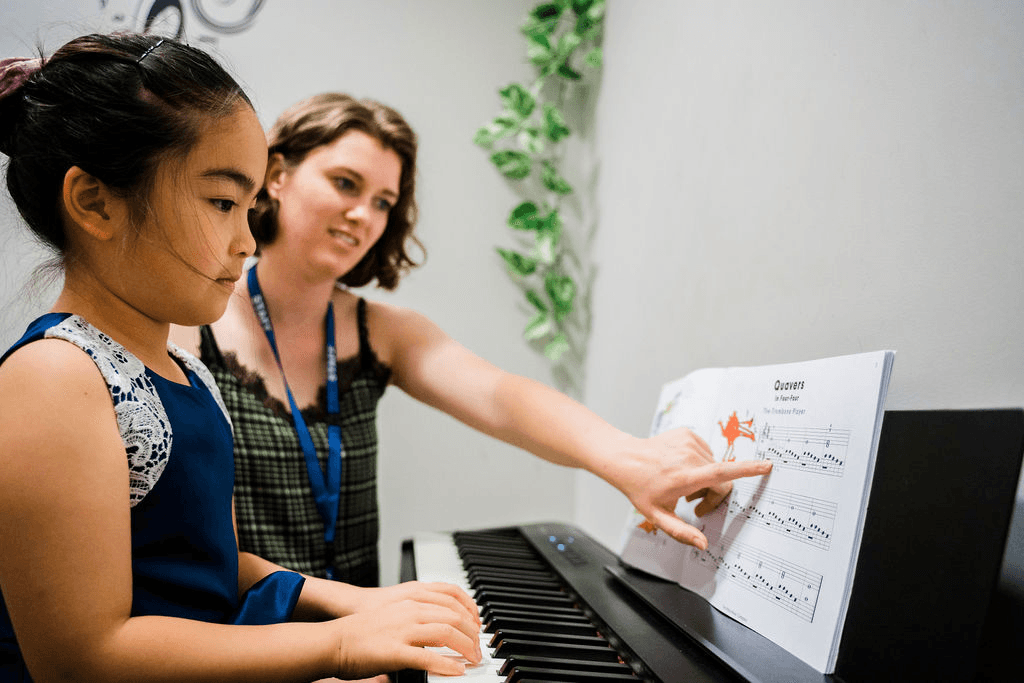
A piano teacher guides a student through reading sheet music during a one-on-one lesson at an electronic keyboard.
5. Independent Musicianship and Critical Self-Assessment
The Dependency Problem
Perhaps the most insidious limitation of piano apps is how their instant feedback systems prevent students from developing self-listening skills. Apps create dependency on external validation rather than fostering internal musical judgement.
Research on piano teaching methods shows that students who rely heavily on immediate digital feedback struggle to develop autonomous practice skills and critical self-evaluation abilities.
Building Musical Independence
Experienced teachers regularly conduct “perform-and-reflect” sessions, recording students and discussing strengths and areas for improvement. They teach practice strategies including goal setting, slow practice techniques, and error-spotting methods that students can apply independently.
Most importantly, teachers provide mentorship that fosters self-confidence, resilience, and growth mindset through carefully scaffolded challenges. Educational psychology research confirms that teacher encouragement significantly enhances student motivation and long-term success.
The Comparison: Apps vs Teachers
| Skill Area | Piano App Limitations | Human Teacher Advantages |
|---|---|---|
| Posture & Technique | Cannot see or correct physical posture, hand position, or body alignment | Real-time visual correction; injury prevention; customised ergonomic guidance |
| Rhythmic Integrity | Often ignore rests; focus only on note accuracy rather than rhythmic understanding | Guided counting exercises; metronome work; ensemble-style activities |
| Aural Skills | Limited ear training; no solfège or improvisation guidance; reliance on visual cues | Solfège training; improvisation prompts; “hear-listen-play” strategies |
| Expression | Cannot teach nuanced dynamics, rubato, or emotional interpretation | Modelling expression; verbal imagery; pedal timing instruction |
| Independence | Instant feedback prevents self-listening skill development; creates dependency | Self-reflection sessions; practice strategies; confidence building |
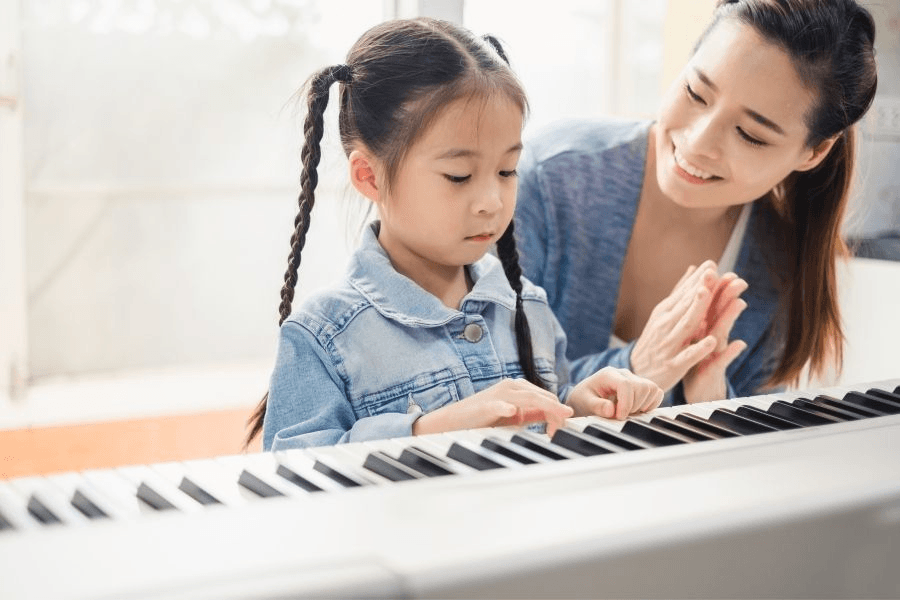
The Social and Psychological Dimensions
Learning piano involves complex psychological factors that apps simply cannot address. Research on the Pygmalion effect in music education demonstrates that teacher expectations and encouragement directly influence student performance and motivation.
The relationship between teacher and student creates accountability, emotional support, and personalised challenge levels that adapt to individual needs and personalities. This human connection is particularly crucial for children, whose musical development depends heavily on positive reinforcement and social interaction.
When Apps Have Their Place
This isn’t to say that piano apps are entirely without merit. They can serve as useful supplements for note recognition, basic theory review, and maintaining engagement between lessons. Studies on mobile applications in piano teaching show that some teachers successfully integrate apps as reinforcement tools rather than primary instruction methods.
However, the key word is “supplement.” Apps work best when used alongside, not instead of, qualified human instruction.
Making the Right Choice for Your Musical Journey
The evidence is clear: whilst piano apps can provide convenient access to basic musical concepts, they cannot replace the comprehensive, personalised guidance that a skilled teacher provides. The five skills outlined here—proper technique, rhythmic integrity, aural development, expressive communication, and independent musicianship—form the foundation of genuine piano artistry.
For parents considering piano lessons for their children, or adults embarking on their musical journey, investing in quality human instruction pays dividends that last a lifetime. The skills learned from a good teacher don’t just make you a better pianist; they develop cognitive abilities, emotional intelligence, and self-discipline that benefit every aspect of life.
Research consistently shows that piano learning enhances cognitive function, improves mood, and increases quality of life—but these benefits are maximised when instruction addresses the whole musician, not just note recognition.
The choice between an app and a teacher isn’t really about convenience or cost—it’s about whether you want to learn to press keys or truly learn to make music. The difference is profound, and only a human teacher can guide you to the latter.
Can piano apps be useful at all, or should I avoid them completely?
Piano apps aren’t entirely worthless—they can serve as useful supplements for note recognition, basic theory review, and keeping you engaged between lessons. Some teachers successfully integrate apps as reinforcement tools rather than primary instruction methods. However, the key word is supplement. Think of apps like exercise videos: they might help you learn basic movements, but you wouldn’t trust them to correct your form or prevent injuries. Use apps to support your learning with a human teacher, not replace it.
How can I tell if I'm developing bad posture habits when learning piano?
Common warning signs include aching hands, wrists, or shoulders after practice, tension in your neck or upper back, and feeling like you’re “fighting” the piano to produce sound. If you notice rigid fingers, collapsed wrists, or find yourself hunching over the keys, these are red flags. The scary part is that harmful habits become muscle memory incredibly quickly—what starts as slightly uncomfortable positioning can develop into chronic pain within months. This is precisely why research on piano-related injuries shows pianists experience higher rates of playing-related disorders compared to other musicians.
My child has been using a piano app for months and can play several songs. Isn't that good progress?
While it’s wonderful that your child is engaged with music, playing songs correctly isn’t the same as learning piano properly. Apps typically teach students to follow visual cues rather than develop genuine musical understanding. Your child might be able to reproduce pieces when watching falling notes, but can they play the same pieces from sheet music? Can they hear when they make mistakes? Do they understand rhythm beyond just following the cursor? Educational psychology research shows that teacher-led instruction significantly improves student engagement and creates deeper musical comprehension compared to isolated app practice.
Is online piano teaching with a human teacher really as effective as in-person lessons?
Online piano lessons with qualified teachers are far more effective than any app, and nearly as effective as in-person instruction when done properly. The key difference is that a human teacher can see your posture, correct your technique in real-time, provide immediate feedback on your expression, and adapt their teaching to your individual needs. Research on piano teaching methods demonstrates that human instruction improves learning efficiency significantly compared to digital-only approaches. Online lessons give you access to qualified teachers regardless of your location, whilst still providing the personal guidance that apps simply cannot offer.
How long does it take to fix bad habits developed from using piano apps?
The time needed to correct poor habits varies greatly depending on how long you’ve been practising incorrectly and how ingrained the habits have become. Generally, it takes approximately three times longer to unlearn a bad habit than to learn the correct technique from the start. For example, if you’ve been using poor hand position for six months, it might take 12-18 months of focused work with a proper teacher to fully correct it. This is why starting with qualified instruction is so important—prevention is always easier than correction. However, don’t despair if you’ve already developed some poor habits. With dedication and proper guidance, most technical issues can be resolved, and you’ll emerge as a much stronger pianist

